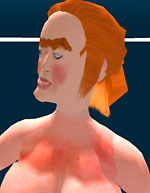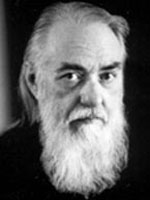
Alan Sondheim reviews
The Flowers of Evil
by Charles Baudelaire, translated by Keith Waldrop
Wesleyan University Press, 2006
This review is about 3 printed pages long.
paragraph 1
I read a review of the book in the New York Times Book Review, and thought it odd, as did a commentator, I think on Poetics, who noticed the review talked about Baudelaire, not the translation. It’s hard to talk about either at this point, particularly after Benjamin and numerous editions of FoE, good initials in English indicative of the difficulty of the original in the first and last place. For years by the way I preferred Edna St Vincent Millay’s translation; the edition itself was neat, and the collusion of what at times feels like late-night preppy writing in combination with the alteriority of underwater columns worked beautifully; the poets held hands and maybe more somewhere or other out of sight.
2
Keith’s book fascinates me, in particular because of the violence it does to the text, or at least what appears to me as a violence, and a ‘tenor’ in the translation that strikes me as Jon Stewart meets Bartok; it’s a kind of breeziness across what appears as the subterranean rootings of melancholy, a bridge across that, which is far too often, for me, the bridge of the fast read, which this translation is not. So a contradiction at the beginning. This is founded, for me, on the belief, that the unconscious plays an enormous role in FoE and that the unconscious is, in fact, not breezy, but on the order of the Kristevan chora – inchoate, dark, abject – the murmurings, not the signposts, of language.
3
Page xvii of the Introduction states: “The book, accused of (get this) ‘realism,’ was found injurious to ‘public morality’ – not, by the way, to ‘public religion,’ a more serious charge.” The “(get this)” gets me; let’s take the translator at his word, assume in fact that the book is realism, realistic; the “(get this)” assumes I assume a collusion between translator and reader that, yes, this is ridiculous; certainly any banning might be ridiculous, but the issue of “realism” – for I also assume the book is realistic, realism – is something else. “get this” bypasses the possibility, not even dismissing it, but closing down, repressing, the possibility, a matter between translator and reader that disallows that radical translation that might consist of the return of the repressed, in this case, this repressed.
4
I love the book as a book of and by Keith Waldrop and as an interpretation of Baudelaire; I miss the radical hardness, indigestability, of Baudelaire, however, which is what constitutes, for me, the aporia of his work that depends in fact on both censer and censor. In FoE, everything drowns; La Chevelure goes on about this:
5
Je plongerai ma tête amoureuse d'ivresse
Dans ce noir océan où l'autre est enfermé;
Et mon esprit subtil que le roulis caresse
Saura vous retrouver, ô féconde paresse,
Infinis bercements du loisir embaumé!
6
So obvious shades of Rimbaud’s retrogressed Son. In any case, the translation: “I will plunge my head, passionately drunken, into this dark ocean imprisoning the other – and my discerning mind, caressed by sea surge, will find you again, O fecund indolence? Infinite lull of balmy playtime!”
7
“loisir embaumé”seems to make its way to the playground, but it might just be my connotative meandering. There’s skittering on the surface, something like a killdeer by the shore, but ’gsomething’s lost in the translation’– in spite of Quine’s salvaging the translation (no reference here), it always happens, but here what’s gone is the abject, which today is not only a mechanism for slow-time, but a form of obdurate of the real (that realism again), the messiness of the real, the real that drags you down drawn dawn drowned etc. And for me the value in Baudelaire – well, the bleak joy of Baudelaire – is precisely in this, the dragging-down, the abject, the lurid which underlies the world, calls and glistens, transgresses. It’s the difference between Web2.0 and Web0.0, between a Web of quick communality and playtimes, and a Web just barely emergent from the Parmenidean mud which frightened Socrates for a moment out of the ideality of forms. Web2.0 is all superstructure; Waldrop’s translation takes off, sutures above the mess, just so. Web0.0 is sweat, labor, grease; think of 2 as electronic, 0 as electric or static-electric.
8
If we all have our Baudelaires and FoEs, certainly Waldrop’s is more astute than mine. But then there’s “I have not tried to trim down this Lovecraftian side of Baudelaire, nor have I tried to foreground it.” I think of Lovecraft’s craft precisely as that, as craft, in fact as a form of mechanism, devouring-machine, but Baudelaire, in my limited world of romance-Romantic, conjures up an uncanny that stipulates (quote from Waldrop from Baudelaire) “that Joy has no part in Beauty, but I do claim Joy as among its most vulgar ornaments; whereas Melancholy is, as it were, its steady companion – to the point that I can hardly conceive ... any type of Beauty without Unhappiness.”To be sure, I can’t either, but this seems veering away from Waldrop, towards those depths. There’s the question of rhyme.
9
Waldrop “leans on the verset, a measured prose that allows the sentence to dominate, as in prose, checked by a sense of line that restricts it. The restriction is rhythmic, not metrical. The model, in English usage, is the biblical verse, especially that of the Psalms, as translated in early English versions, including the King James.” Well, the KJ version is miles away from the Hebrew; it construes linearity where that might have been none, confuses tenses, loses wordplay and gematria, and so forth. The surface is something else, Waldrop is something else. There’s the question of rhyme.
10
With my poor French and Hebrew, rhyme tightens the noose, releases it, almost a form of suffocation-masturbation in Baudelaire. FoE is veined, marmoaceous, stone and stone; the words have weight, they drag the abject into them, they ring the real, in the process wring it. We need this discomfort now, when words are spewed by the petabytes; we need this smear, this blockage, this frottage, this frisson. I love Waldrop; he’s far more pleasurable. But I love Baudelaire’s dis/comforting for the rest of is, his dis/ease. This is realism, this lurid that we try and hide beneath the bed, forgetting the bedpan, forgetting what’s happening just above, just below us.
11
As a postscript I realize I’m not being fair to Keith, who was a perhaps unwilling mentor of mine, when I desperately needed support (not like now, when I desperately need support). But this is about Baudelaire, about double strands, double texts, and I love them both, not as mirror or distorting mirror, but for different reasons, and far different rhymes.
| |

|
|
| |
|

|